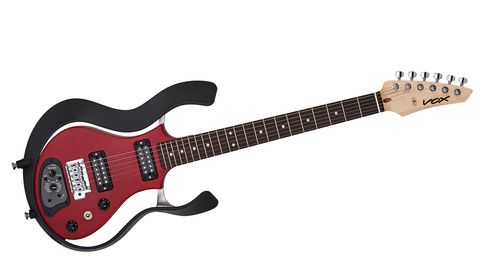The name might be taken from Vox's past, but make no mistake, the Starstream is a future shock of a guitar.
The basic build - maple neck with rosewood 'board mounted to a wooden body, is rather standard, even if mango wood is an unusual body choice. But its plastic frame certainly isn't, nor the cast aluminium frame that connects the top horns with the screws that hold the neck to the guitar's body amid a sea of air.
If that's not enough, aside from two conventional narrow mini- humbuckers we have a piezo-loaded vibrato that combines with the onboard electronics to offer 27 different 'modelled' sounds.
The Vox AREOS-D system also includes drive or reverb as adjustable onboard effects, although the former is assigned, broadly speaking, to the 'electric' sounds and the latter to the 'acoustic' sounds.
The hardware is housed under a grey-topped panel with controls to select the different banks and apply effects. It all runs off four AA batteries.
An adventurous guitarist will have lots of fun here.
If you're not already running to cuddle your Strat, we can report that it's not quite as bonkers as it looks. First off, the Fender-like neck, with a slightly shorter scale, is a nice player.
It's also comfy to play thanks to that ergonomically- shaped outer frame, and pretty lightweight (7.1kg). Tuners and the two-post vibrato are tidy, too.
Unlike Line 6's Variax, the only other digital modelling guitar of any note, the Starstream uses both its magnetic and piezo pickups - often in combination - to produce the wide array of sounds. So, for example, both 'buckers are active in the Acoustic 2's Nylon sound as well as the synth sounds in the Specialist bank. But we're getting ahead of ourselves...
With little technical spec to go on let's dive in and see what happens.
The first bank, 'Single', voices the 'buckers' single coils in usual neck, both, bridge fashion. 'B'tween' combines the coils and adds some processing, we'd imagine, for three Strat-y in-between flavours that are also hum-cancelling. 'Humbucker' is self-explanatory, while 'Modern' offers neck single coil, bridge single coil and bridge 'bucker. All credible enough.
The piezo is introduced in the '12String' bank, which sounds synthetic but usable with care, and two 'Acoustic' banks. These include good large and small size acoustic voices, a more credible 12-string, dubious nylon, good resonator, sitar (but with an odd sustain envelope), and okay banjo.
The final selection, 'Special', offers squashy synth, bass synth - but no electric bass, which is a shame - and an unwieldy organ-like sustain sound.
You can dial in a fruity overdrive to the 'electric' sounds - sadly not the synths - and a spacious reverb to the Acoustic and Special voices. You can then store the sound and all its settings.
The Starstream isn't cheap yet it does offer a selection of diverse, mainly useful sounds in an easy to use package.


